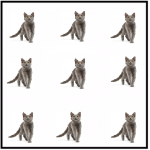МОУ школа №153
с углубленным изучением
иностранных языков
Science-fiction in the creation
of N. V. Gogol and G.Walse
on the example of "The Nose" and "The Invisible Man"
Pupil
Golubeva Nadezhda
7"b" Form
Teacher:
Chugaeva Veronika Vladimirovna
The Plan
I The introduction....................................................................
................. 3
II The basic part
1. Fantasy and Science fiction.................................................................. 4
2. The analysis of Gogol"s creation............................................ …........... 5
3. The analysis of Walse"s creation........................................................... 7
4. A short re-telling of "The Nose"... ................................................................. ...8
5. The analysis of "The Nose" ……………………………………………… 9
6. The analysis of "The invisible Man".......................... ………………..10
III The conclusion......................................................................
............. 11
IV The list of literature......................................................................
.... .12
V The appendix.......................... ........................................................... .... 13-17
The introduction.
· The topic of my report is Fantasy in the creation of N.V.Gogol and Gerbert
Walse on the examples of "The Nose" and "The Invisible Man".
· The problems of it are to study the creation of these two writers and to compare "The Nose" and "The Invisible Man"
· The purpose of my researching work is to find some similarities and differences in the sphere of fantasy.
· To reach this purpose I had some tasks: To analyze the information, I have found and to compare fantasy in "The Nose" and "The Invisible Man".
· The actuality of my work is great; as far as I consider that it is a wonderful way to expand the boundaries of my literature knowledge.
· As for me, this topic is interesting. Firstly since my childhood I have been interested in fantasy and various strange phenomena and secondary I am going to connect my report with the future researching work.
· I have chosen this topic, as I think that my report will be used by the pupils, who are interested in literature or different fantastic things like me.
· While working on my researching work I had some difficuilts. For example finding information in the Russian language and translate from the Russian in to English, making comparison
II The Basic Part.
1. Fantasy and science – fiction.
· Fantasy is a form of representation the world, there fantastic moments mix into the real world. Fantasy expresses the author"s world-view, which is characteristic of the whole epoch.
· Science - fiction is a form of the fantasy, which is devoted to forecasting of the future. The main reception-is a mental experiment. The brightest representatives are G. Walse, K. Chapek, S. Lem, R. Bredbery...
1) The analysis of Gogol"s creation
N. V. Gogol was born on 20th of March in 1809 in place Velikie Sorochentci of Poltavskaya governor. Gogol was the third child of Vasiliy Afanasevich and Mariya Ivanovna. The two eldest had died. Gogol"s perents worried about boy"s fate. The Gogols told that if it bore a boy again they would name him in honour of the Saint Nickolas and it happened.
When a child a was and sensitive. The book called Domesday Book, which his mother used to read, when he was small, formed a strong fear, which had been torturing him from his childhood. Gogol"s way of life made him connect a real prose with terrible fears of the part. The boy"s heart stopped beating, when he was standing in front of the icon of Saint Nickolas, crossing himself. Beginning from the childhood Gogol heard some strange voices behind him, which called his name. People said that such things predict coming death. Au his lite Gogol was afraid of death and punishment in the next world. His mystical experiences of the childhood Gogol described his literature woks. Gogol entered the gymnasia in 1821. In adolescence Gogol"s life was so heavy with the mysticism that it was impossible to distinguish it from reality friengs. His comrades liked him and called Strange. Gogol was sarcastic with regard to his friends and used to give them different nicknames. The main peculiarity of his psychology was the absence of the sense of realism, inability to distinguish the truth from the invention and the inclination to exaggeration. In 1831 "The evenings on the farm near The Dikanka" brought him fame. Gogol followed two traditions in the tale. The first was German romantic witches, devils, exorcisms, and the second was the Ukrainian people fairytale with its middle - aged struggling of Cod and Bad. The tales appeared -in the logical gradation according to Huir graveness. In "The lost documents" and "Enchanted place" mysticism is laughable and "domestic". In "The evenings on the Eve of Ivan Kupala" and "The night of May" the fight of the Good and Bad is complicated. In "The evenings on the Eve of Ivan Kupala" and in the "Terrible place - the laugh falls silent entirely. Exactly there, in the terrible and dark you should look for the manifestation of the soul condition of the author. Gogol wrote that he often thought different funny stories as he only could make out. But soon the funny stories became less and less funny and the darkness of his melancholical character by nature started to reflect in his stores death. The next step was - a final break with the people"s fantasy and the transfer in the reality. All the horns, hoofs and muzzles disappeared. Gogol found himself in the world of grownups and educated people, who did not believe in evils. Such works as "The Nevskiy Boulevard", "The picture", "Viy" belong to this period. There Gogol depicted an angry spirits, an angry beginning, which was penetrated in the world of people. Gogol named the second part of his creation - maturity, in which he entered with the help of Pushkin. Gogol got acquainted with him in 1831.Pushkin gave him a plot of "The Dead Souls" and the thought of "The Inspector". In 1836 it was produced on the St.Petersburg stage. But the play aroused a social indignation. Gogol wrote to his friend that a small sign of the truth and everybody were against him. He expected that Russia would see all the sins and change. But it did not happen. A disappointed author went to German. He wrote "The Greatcoat", "The Dead SouIs"and other works since 1836 to 1842.
At the end of 1841 Gogol went to Russia to print the first volume of "The Dead Souls". It was exposed to criticism and a censorship"s objection. At the end of 1842 Gogol was preparing for the press of the full collection of his compositions in the 4 volumes. This date finished his last literature period of life. During the remaining ten years he moved away his creation.
The analysis of Walse s creation.
G.Walse is a famous writer-dreamer in the history of literature of the twentieth century. He lived a long and wonderful life of eighty years. He was named the clairvoyant, the artist and the journalist. Gerbert was given an honourable role of the writer-discoverer of the science- fiction. This genre appeared when the mankind did not believe in religious learning. Exactly Gerbert asked the question about the responsibility of people in front of the future. And that is why there are only real people, who are solving only human problems. But why did Walse use fantasy if he considered it secondary? All the humane4s discoveries are connected with the strength of the mind. And Gerbert thought the same. But in respective of it he considered the science not as an abstract subject, but in the synthesis of the social problems, which he tried to solve firstly. Gerbert showed the final of his novels, which were always tragically and endless, with the help of science- fiction, caring it to the hyperbola. In the middle of Walse"s attention there are contradictions between an intellectual and physical work ("The first people on the Moon"), a sharp division into the classis of the gentlemen and the slaves ("The Time Machine"), the role of the shock person in the deformed society ("The Invisible Man"). And of course the main is - the fate of the bourgeois society ("The war of the worlds").AH these science-fiction novels brought a tremendous fame to Gerbert Walse. They have been living even today.
A short retelling of "The Nose"
This incident happened on the 25th of March in St. Petersburg when Ivan Yakovlevich was eating fresh bread and found a nose in it. Later he realized that it was Kovalev"s nose. Kovalev was a major and Ivan shaved him every morning. Then Ivan Yakovlevich wanted to find a chance to lose it and decided to throw it out of the Isakievsky Bridge. That time the major realized that he hadn"t his own nose. He went to police man and noticed it in the appearance of a man in the coat and the hart on the street. Kovalev re-told everything he had seen on the street to a police man and in a few days his nose was brought to his house by the employees of the police. But it wasn"t the end of the story the nose wasn"t a suitable to his face. During this time the gossips about The Nose as about a person spread every there. But nevertheless on the 7th of April the nose was on Kovalev"s face. He was so happy that it was very difficult to describe his mood.
The analysis of "The Nose"
"The Nose" is the most fantastic creation of N. V. Gogol. It is a narrative about a usual life, where something unreal happens. It is a special grotesque form of a satirical representation of a reality. A barber Ivan Yakovlevich, found a nose in his bread, then he realized that it was the nose of a major Kovalev, whom he shaved every morning. If it wasn"t a major"s nose if it was a nose of somebody else he would not be so afraided. But it was his nose and this moment worried Ivan Yakovlevich very much. Before the description of Kovalev, first of all Gogol tells us about his rank: We see that Kovalev is rather pleased of it and tries to correspond it and look important. But however Kovalev is not going to be noble and solid he only speed towards to have a nobility and weight and that is why he always calls his grade. He is the hero who believes in the strength of the rank. He is sure that it makes people more meaningful and nobler. Gogol scoffs at such hero, puts him, in unreal and special situation. Once Kovalev woke up early in the morning and there was the place for fantasy, he saw that his nose was absent. The major was in horror because his nose as his side whiskers belonged to a number of his merits. And when Kovalev saw his own nose in the appearance of a man in the coat with gold buttons, with a hat on his head, and with the rapier in his hand, he felt a tremendous shock, it became dark in his eyes and his foots began to shake. A mixture of different feelings overfilled his soul. There was a wish to return his own nose and there was a fear as The Nose looked very solid. But when he realized that The Nose was not a meaningful adviser Kovalev was ready to name him a "scoundrel". It meant that the rank gave him a right not only to feel his significance but still to command with others.
The analysis of "The Invisible Man"
"The Invisible Man" is one of the most fantastic novels of Walse. This novel makes a great impression on people by its rare truthfulness. There is only one science-fiction prerequisite in this novel, it is the invisible man-Griffin. Everything is confirmed through the science-fiction.
Griffin is the main character of the novel. He is an extraordinary, meaningful and talented person. The fate of a broadminded scientist, who tries to oppose to immovable and narrow-minded society, is a tragic. But soon Griffin turns into the monster too, when he has a high opinion of himself and tries to subject the world. Griffin was always unique, a person, who always was tried to subject. Now he will try to do the same by himself. But how? His way to the power will be bloody and cruel. Griffin s methods are so absurd as his aim. He tries to realize himself with the help of terror and violence. He is concentrated only on it. But however Griffin is not indifferent to the readers, as far as he appears before us as a man and the torments of his birth are his own torments. Griffin appears as an invisible man in our eyes. Walse draws a real man and arouses a human interest to him. Griffin is the same as the society makes him.
The conclusion
• Having compared these two works I realized that in respective of all the similarities of Gogol"s and Walse"s creation, they wrote in different genres. The firs wrote in fantastic genre and the second in science-fiction.
• Both Gogol and Walse were discoverers of their genres. The principles of the real grotesque were announced and successfully reliazed successfully firstly in Russian literature by Gogol. And Walse was the founder of a new scientific fantasy. He predicted the future.
• We see that the main character of "The Nose" is a servant, who is provided with a power, but who doesn"t worthy to it. And Walse, on the contrary, put a talented scientist, who didn"t find his place in the society, in the middle of the novel.
• It is evident that both "Nose" and "The invisible man" are united by the appearance of unreality in the real life. The nose in the story is separated from a man and continues existence in the same world, between the people. And in "The invisible man", it is the appearance of the invisible man, himself.
• It is undoubtedly true that both Gogol and Walse use a fantastic receptions for the indication of the defects of the society:
for example Gogol scoffs at his hero and puts him in uncommon and especial circumstances, bringing them to absurd extreme and nonsense by the fantasy. And Walse shows us the life of the rich average men, which hate everybody who does not like them, though the fantasy too.
• So I consider that the problem of my report, to find out similarities and differences in the sphere of fantasy on the examples of "The Nose" and "The Invisible man" of N.V. Gogol and G. Walse, has been solved. And as the result of it I have made a small comparative table:
A comparative table
| Differences | Similarities |
| 1. Genres (fantastic, science- | 1. the aims of the works (to stress |
| fiction). | the defects of the society). |
| 2. Artistic principles (grotesque, | 2. Unreality in the real lifes. |
| realism) | |
| 3. A contrast of the main | 3. The writers are discovers of |
| characters. | their genre. |
The list of literature
1. А. Г. Андреева /История зарубежной литературы XX века /1980
2. И. Золотуеский /Жизнь замечательных людей /1998
3. И. Н. Мещерякова /Зарубежная литература /1989
4. К» Мочульекий /Духовный путь Гоголя /1934
5. Д. Николаев /Сатира Гоголя /1984
.













 (zip - application/zip)
(zip - application/zip)










